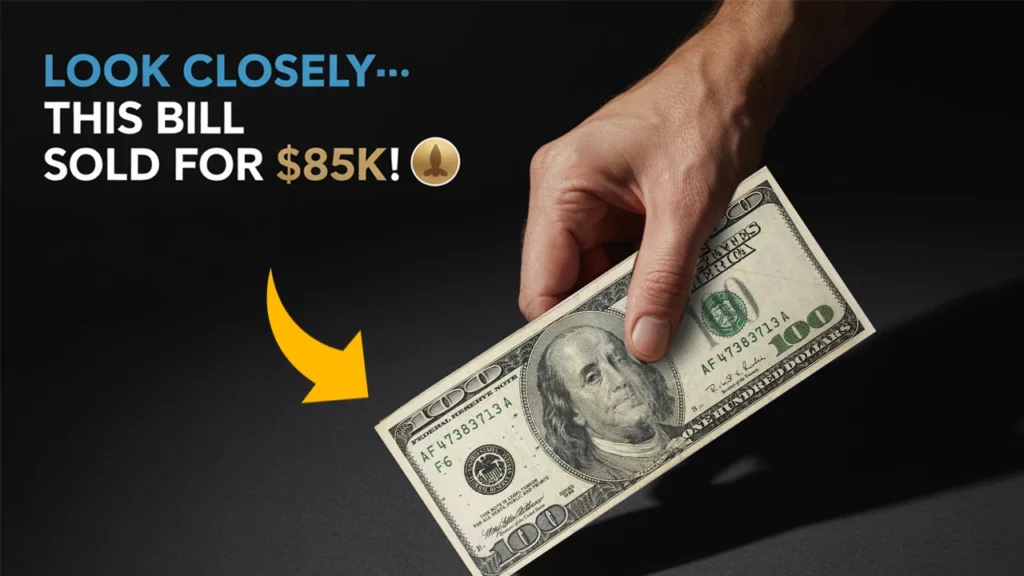A $100 bill might not look like much more than spending money — unless it has a rare printing error. In a recent auction, a $100 bill with a misaligned seal stunned collectors by fetching $85,000, turning everyday currency into a collector’s prize. If you’re in the U.S. and regularly handle cash, this might be the perfect time to double-check your wallet or cash drawer.
Here’s how to identify one of these valuable error bills and what makes them worth thousands more than face value.
What Is a Misaligned Seal Error?

Every U.S. bill features a green Department of the Treasury seal on the right side and a black Federal Reserve seal on the left. In normal bills, both are neatly aligned in their designated areas.
But in some rare printing errors, one of these seals — usually the green Treasury seal — is misplaced or off-center, either too high, too low, or even overlapping the portrait or denomination numbers. This printing mistake is what’s referred to as a misaligned seal error.
These types of errors escape the usual strict quality checks at the Bureau of Engraving and Printing and make it into circulation — making them both rare and highly collectible.
The $85,000 Discovery That Sparked Headlines
Recently, a $100 bill with a severely misaligned green seal appeared at an online auction. The seal was shifted so far to the left that it overlapped Benjamin Franklin’s portrait — a clear sign of a misprint.
While the bill itself remained uncirculated and in pristine condition, it was the error that made it a headline-worthy item. After competitive bidding from collectors, it finally sold for $85,000 — an incredible 850 times its face value.
This sale has now drawn major attention to currency errors, especially among collectors and even casual enthusiasts.
What Makes These Error Bills So Valuable?
Misaligned seals alone don’t guarantee high value. Several factors influence how much an error note is worth:
- Severity of the misalignment – Minor shifts may not be valuable, but dramatic misplacements are in demand.
- Condition of the bill – Uncirculated or crisp notes are more valuable than worn or damaged ones.
- Series and serial number – Bills from certain series or with unique serial numbers (like star notes or repeaters) can fetch even higher prices.
- Rarity – The fewer misaligned seal errors known for a specific series, the more valuable each one becomes.
How to Check Your $100 Bills for This Error
You don’t need any fancy tools — just a careful eye. Here’s what to do:
- Look at the green seal on the right side of your $100 bill.
- Is it perfectly aligned between the portrait and the right-hand text?
- If it’s noticeably shifted, especially into the portrait area or off its intended position, you may have an error note.
- Compare it with another $100 bill or an online image of a normal one to spot discrepancies.
What to Do If You Find One
If you think you’ve found a $100 bill with a misaligned seal:
- Do not spend it – It’s potentially worth far more than $100.
- Preserve it carefully – Avoid folding or damaging the note.
- Get it authenticated – Reputable grading companies like PCGS or PMG can certify the error.
- Consult an expert or auction house – They can help you understand its market value and even assist with selling it.
Why These Stories Are Gaining Popularity
With stories of rare coins and bills going viral, more Americans are becoming curious about the cash in their pockets. Currency errors — once known only in niche collector circles — are now part of everyday conversations.
Unlike collecting rare coins that often require years of knowledge, paper currency errors are easier to identify and more accessible to the average person.
Final Thoughts
The story of a $100 bill turning into $85,000 reminds us that even common currency can hide uncommon value. Whether you’re a seasoned collector or someone who occasionally uses cash, this is your sign to take a closer look.
So next time you’re handed change or pulling cash from the ATM, don’t just stuff it into your wallet — inspect it. That misaligned seal might just make your day.
